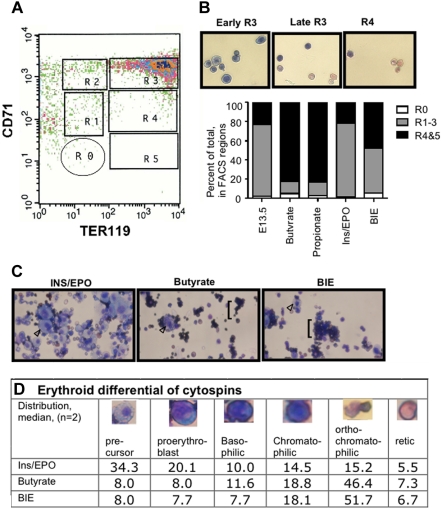Figure 3.
Erythroid differentiation of SCFA-treated eFLCs. (A) FACS analysis of fresh uncultured E13.5 eFLCs, immunostained with antibodies against CD71 and TER119, is shown. Gates for regions of progressive erythroid differentiation, as published by Zhang et al30 are R0 (nonerythroid and lineage negative cells), R1 through R3 (progenitor cells, proerythroblast, and early basophilic erythroid precursors), and R4 and R5 (chromatophilic and orthochromatophilic erythroid precursors, plus reticulocytes). (B) Wright-Giemsa–stained cytospins from FACS-sorted E13.5 wt eFLCs (40×, Nikon Eclipse TE 2000-5 with a Nikon LUD lens; Nikon, Melville, NY) that had been cultured in ins/EPO are shown for regions R3 (basophilic and orthochromatic erythroid precursors) and R4 (orthochromatophilic erythroid precursors and reticulocytes). Shown also is a graph of quantitative analyses of R0-R5 for fresh (n = 2) and cultured E13.5 eFLCs (n = 4 pooled eFLCs in butyrate, propionate, or ins/EPO; n = 2 butyrate and ins/EPO). SCFA-treated eFLCs had a relative increase in more differentiated erythroid cells, in regions R4 and 5, compared with ins/EPO-only treated cells, 77.5% (± 4.0%) in propionate-treated or 65.5% (± 9.9%) in butyrate-treated eFLCs compared with 21.5% (± 3.5%) in ins/EPO-treated eFLCs (P < .05). BIE-treated eFLCS had an intermediate differentiation pattern, at 57.2% (± 9.0%) (P = n.s. to SCFAs alone, P = .08 to ins/EPO alone). (C) Wrights-Giemsa–stained cytospins of eFLCs (40×, Nikon Eclipse TE 2000-5 with a Nikon LUD lens) that had been cultured for 72 hours in ins/EPO, butyrate, or both BIE. Early erythroid precursors (arrowhead ▷) are prominent ins/EPO-only treated cells, while mature erythroid cells (brackets) predominate in butyrate-containing media, with or without ins/EPO. (D) Median differential cell count of erythroid precursors (%) from eFLCs that had been cultured in ins/EPO, butyrate, or BIE (200 cell counts from 2 independent experiments).

